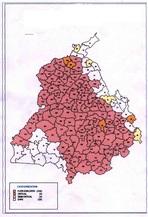Punjab
Prevalence of dental fluorosis and associated risk factors in school children from Kanyakumari district, Tamil Nadu - Paper published in the Indian Journal of Dental Research
Posted on 22 Feb, 2012 01:51 PMA total of 1800 children from all the nine blocks of Kanyakumari district from 6th to 10th standard were examined using type III examination. Dental fluorosis was present 15.8% of the study population and varied from as low as 1.4% to as high as 29.4% in different areas. There was a significant difference in dental fluorosis levels between rural and urban residents.
Zero tillage in the rice-wheat systems of the Indo-Gangetic plains - A review of impacts and sustainability implications by IFPRI
Posted on 31 Oct, 2011 06:49 PM This paper by the International Food Policy Research Institute (IFPRI) reviews the success of zero-tillage wheat in the rice-wheat systems of the Indo-Gange
This paper by the International Food Policy Research Institute (IFPRI) reviews the success of zero-tillage wheat in the rice-wheat systems of the Indo-Gange
Chemical fertilizers in our water - An analysis of nitrates in the groundwater in Punjab by Greenpeace
Posted on 31 Oct, 2011 09:00 AM The level of nitrate in drinking water was tested from groundwater artesian wells located within farms and surrounded by crops (mostly rice and wheat rotations).
The level of nitrate in drinking water was tested from groundwater artesian wells located within farms and surrounded by crops (mostly rice and wheat rotations).
Nitrate pollution in groundwater is associated with nitrogen loads in the environment. In urban areas, it is associated with sewage and in agriculture areas, with livestock sources and nitrogen fertiliser inputs. Nitrate pollution in drinking water can have serious health impact on humans, especially for babies and children. The most significant potential health effects of drinking water contaminated with nitrate are the blue-baby syndrome (methemoglobinemia) and cancer.
Economic and Political Weekly 2011: Review of Agriculture (June 25 - July 8, 2011)
Posted on 28 Jul, 2011 02:25 PM
Issue: VOL 46 No. 26 and 27 Jun 25 - July 08, 2011
Review of Agriculture
Irrigation in Telangana: The Rise and Fall of Tanks
Gautam Pingle
Fazilka citizens protest against planned encroachment on ecosensitive Badha lake wetland by Punjab Urban Development Authority (PUDA)
Posted on 21 Jul, 2011 04:16 PMForwarded to the portal by: Graduates Welfare Association, Fazilka
A natural system and an agricultural philosophy - A small-holder farmer in Punjab turns his land from a lifeless, debt ridden farm into a healthy, productive and profitable one - A film by The Source Project
Posted on 13 Jul, 2011 12:24 PMArticle and Video courtesy: The Source Project
Water crisis and water chaos in Punjab - An article by Umendra Dutt, Kheti Virasat Mission
Posted on 23 Jun, 2011 02:08 PM Last month Punjab has been declared as the over all best state in the country by India Today news magazine for the third conjunctive year. It is good to have a prize for Punjab and state government has immediately taken this as an opportunity to have publicity campaign for its achievement. But there is another side of the picture also which shows doom, distress and destruction is fast engulfing this land of five waters. It is a Water-Chaos in the Punjab.
Last month Punjab has been declared as the over all best state in the country by India Today news magazine for the third conjunctive year. It is good to have a prize for Punjab and state government has immediately taken this as an opportunity to have publicity campaign for its achievement. But there is another side of the picture also which shows doom, distress and destruction is fast engulfing this land of five waters. It is a Water-Chaos in the Punjab.
Bio-remediation project announced for Buddha Nala, Ludhiana - MoEF Press release
Posted on 13 Apr, 2011 11:14 AMFollowing the invitation of Member of Parliament (Ludhiana) Mr. Manish Tewari, the Hon’ble Minister for Environment and Forests Mr. Jairam Ramesh along with officials of the Ministry of Environment and Forests including the Chairman of the Central Pollution Control Board, visited the site of the Buddha Nala in Ludhiana, Punjab in September of 2010.
Saraswati – The ancient river lost in the desert - A paper from Current Science
Posted on 12 Apr, 2011 01:26 AMThis Current Science paper uses secondary data to discuss the disappearance of the river Saraswati. The enigma that was the disappearance of this river, which according to the author once upon a time greened Rajasthan and had nurtured civilizations on its shore, brought archaeologists, geologists, geophysicists, and climatologists to find answers. The author uses the body of work created by these scientists to solve the puzzle of the disappearance of the Saraswati.
Harvest of Grief: A film by Rasil Basu and Ekatra Production that explores the severe agricultural crisis in Punjab
Posted on 22 Mar, 2011 02:48 PM